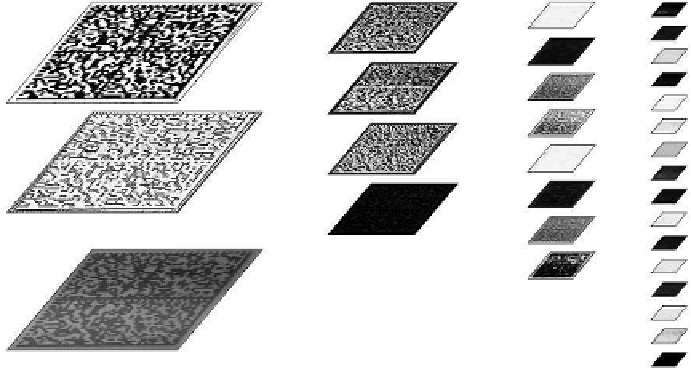Information Technology Reference
In-Depth Information
8.5 Learning Binarization
If one wants to develop a binarization method that outperforms adaptive threshold-
ing, one has to utilize the structure present in the data. More specifically, one can
expect a method to perform well that recognizes the Data Matrix cells and assigns
white or black to an entire cell, and not to single pixels. Of course, one could de-
velop manually an algorithm that works in this way, but the purpose of the following
experiment is to demonstrate that it is possible to solve the problem without the need
to think about an application-specific algorithm.
The approach followed is to use a general-purpose tool, the Neural Abstraction
Pyramid introduced in Chapter 4, and adapt it to the specific task by learning from
input-output examples. The generalization performance of the trained network is
tested and compared to the adaptive thresholding method.
The architecture of the Neural Abstraction Pyramid network used for binariza-
tion is sketched in Figure 8.10. It has four layers with an increasing number of
feature arrays and decreasing resolution. Layer 0 contains the input image and two
additional feature arrays of size 216
×
216. The number of feature arrays doubles,
while their resolution is halved when going to the next layer, until Layer 3 is reached,
where 16 feature arrays of size 27
×
27 are present. A two pixel wide border sur-
rounds the feature arrays. The activities of the border cells are copied from feature
cells using wrap-around.
The network's processing elements contain output-units with a sigmoidal trans-
fer function
f
sig
(
β
= 1
, see Fig. 4.5(a) in Section 4.2.4). They receive input from
Output
Input
Layer 0 (216x216)
Layer 1 (108x108)
Layer 2 (54x54) Layer 3 (27x27)
Fig. 8.10.
Architecture of the Neural Abstraction Pyramid network used for learning the
binarization of Data Matrix codes. The network consists of four layers shown from left to
right. As the number of feature arrays increases from layer to layer, the resolution of the
layers decreases.


Search WWH ::

Custom Search